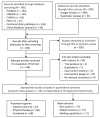Comparative Efficacy of Intra-Articular Injection, Physical Therapy, and Combined Treatments on Pain, Function, and Sarcopenia Indices in Knee Osteoarthritis: A Network Meta-Analysis of Randomized Controlled Trials
- PMID: 37047058
- PMCID: PMC10094194
- DOI: 10.3390/ijms24076078
Comparative Efficacy of Intra-Articular Injection, Physical Therapy, and Combined Treatments on Pain, Function, and Sarcopenia Indices in Knee Osteoarthritis: A Network Meta-Analysis of Randomized Controlled Trials
Abstract
Knee osteoarthritis (KOA) is associated with a high risk of sarcopenia. Both intra-articular injections (IAIs) and physical therapy (PT) exert benefits in KOA. This network meta-analysis (NMA) study aimed to identify comparative efficacy among the combined treatments (IAI+PT) in patients with KOA. Seven electronic databases were systematically searched from inception until January 2023 for randomized controlled trials (RCTs) reporting the effects of IAI+PT vs. IAI or PT alone in patients with KOA. All RCTs which had treatment arms of IAI agents (autologous conditioned serum, botulinum neurotoxin type A, corticosteroids, dextrose prolotherapy (DxTP), hyaluronic acid, mesenchymal stem cells (MSC), ozone, platelet-rich plasma, plasma rich in growth factor, and stromal vascular fraction of adipose tissue) in combination with PT (exercise therapy, physical agent modalities (electrotherapy, shockwave therapy, thermal therapy), and physical activity training) were included in this NMA. A control arm receiving placebo IAI or usual care, without any other IAI or PT, was used as the reference group. The selected RCTs were analyzed through a frequentist method of NMA. The main outcomes included pain, global function (GF), and walking capability (WC). Meta-regression analyses were performed to explore potential moderators of the treatment efficacy. We included 80 RCTs (6934 patients) for analyses. Among the ten identified IAI+PT regimens, DxTP plus PT was the most optimal treatment for pain reduction (standard mean difference (SMD) = -2.54) and global function restoration (SMD = 2.28), whereas MSC plus PT was the most effective for enhancing WC recovery (SMD = 2.54). More severe KOA was associated with greater changes in pain (β = -2.52) and WC (β = 2.16) scores. Combined IAI+PT treatments afford more benefits than do their corresponding monotherapies in patients with KOA; however, treatment efficacy is moderated by disease severity.
Keywords: injection; meta-analysis; mobility; osteoarthritis; pain; physical therapy; sarcopenia.
Conflict of interest statement
The authors declare that they have no conflicts of interest regarding the publication of this article.
Figures






References
-
- Chen L.K., Woo J., Assantachai P., Auyeung T.W., Chou M.Y., Iijima K., Jang H.C., Kang L., Kim M., Kim S., et al. Asian Working Group for Sarcopenia: 2019 Consensus Update on Sarcopenia Diagnosis and Treatment. J. Am. Med. Dir. Assoc. 2020;21:300–307.e302. doi: 10.1016/j.jamda.2019.12.012. - DOI - PubMed
Publication types
MeSH terms
Substances
Grants and funding
LinkOut - more resources
Full Text Sources

